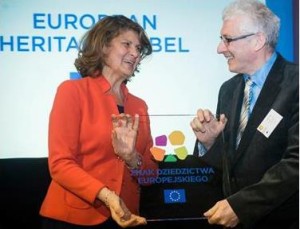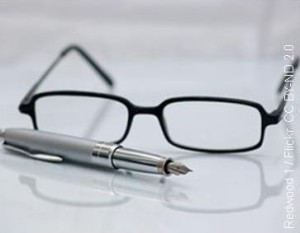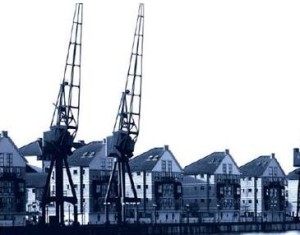 On 15 April, members of the CHCFE Steering Committee attended the European Heritage Label (EHL) Award Ceremony. Held at the Bibliothéque Solvay in Brussels, the ceremony commemorated the sixteen heritage sites from 10 countries chosen to receive the label in 2015. During his opening speech, Tibor Navracsics, European Commissioner for Education, Culture, Youth and Sport said: “Heritage is a vital part of our collective identity as Europeans. It roots us firmly in our past, but it also helps us to shape our vision of the Europe of the future. It is a source of inspiration for thinkers and artists and the driver of our cultural and creative industries.” In front of an audience of policy makers, culture and heritage professionals, and representatives of European networks, Silvia Costa, MEP and Chair of the Committee on Culture and Education handed out the Award plaques to each winner.
On 15 April, members of the CHCFE Steering Committee attended the European Heritage Label (EHL) Award Ceremony. Held at the Bibliothéque Solvay in Brussels, the ceremony commemorated the sixteen heritage sites from 10 countries chosen to receive the label in 2015. During his opening speech, Tibor Navracsics, European Commissioner for Education, Culture, Youth and Sport said: “Heritage is a vital part of our collective identity as Europeans. It roots us firmly in our past, but it also helps us to shape our vision of the Europe of the future. It is a source of inspiration for thinkers and artists and the driver of our cultural and creative industries.” In front of an audience of policy makers, culture and heritage professionals, and representatives of European networks, Silvia Costa, MEP and Chair of the Committee on Culture and Education handed out the Award plaques to each winner.
The European Heritage Label sites were chosen by an independent selection panel because they are about much more than just aesthetics. They go beyond to celebrate and symbolise European integration, ideals, values and history. The sites were also carefully selected for the activities they offer in order to bring the European Union and its citizens closer together. This includes organising a wide range of educational activities, especially for young people. Together, the sites can give visitors a real feel for the breadth and scale of what Europe has to offer and what it has achieved.
“For those of us spending most of our time at a computer screen, to hear the inspiring stories and take in the personal energy of the European Heritage Label winners more than justified our behind-the-scenes work on policy and practice with the Cultural Heritage Counts for Europe project. The winners from across Europe fully demonstrate yet again that the diversity of our cultural heritage is one of Europe’s greatest assets,” said Kate Pugh, member of the CHCFE Steering Committee and Chief Executive of The Heritage Alliance in the United Kingdom.
“The European Heritage Label Ceremony was a very inspiring evening which invited us to interpret cultural heritage widely by embracing not only historical monuments and sites but also historical events and personalities as an integral part of our common European cultural heritage. We congratulate the sixteen sites who received the Label for their commitment to promote the European idea and ideal,” added Sneška Quaedvlieg – Mihailovic, Secretary General of Europa Nostra who is leading the CHCFE project.
The European Heritage Label began as an initiative of several national governments to improve knowledge of European history, as well as the role and values of the EU. It was formally established in 2011 and the first selection of sites took place in 2013.
Learn more about the 16 awarded sites and about the European Heritage Label: http://ec.europa.eu/programmes/creative-europe/actions/heritage-label/index_en.htm
 The CHCFE project is reaching the end of its work to produce a report on the multiple benefits of cultural heritage in Europe. In preparation for the report’s publication in date June 2015, members of the project’s Steering Committee held an informal meeting in Brussels on 15 April to finalise the committee’s policy recommendations based on the main findings of Cultural Heritage Counts for Europe. These recommendations for tapping into heritage’s full potential will be included in the first part of the report that also presents the institutional and policy context, the scope and scale and the main findings. The results of Cultural Heritage Counts for Europe will be presented on 12 June in Oslo, Norway in the larger framework of the 2015 Europa Nostra Congress.
The CHCFE project is reaching the end of its work to produce a report on the multiple benefits of cultural heritage in Europe. In preparation for the report’s publication in date June 2015, members of the project’s Steering Committee held an informal meeting in Brussels on 15 April to finalise the committee’s policy recommendations based on the main findings of Cultural Heritage Counts for Europe. These recommendations for tapping into heritage’s full potential will be included in the first part of the report that also presents the institutional and policy context, the scope and scale and the main findings. The results of Cultural Heritage Counts for Europe will be presented on 12 June in Oslo, Norway in the larger framework of the 2015 Europa Nostra Congress.
 The report of the Horizon 2020 expert group on cultural heritage is now available online. The ‘Getting cultural heritage to work’ report is an important development for the heritage sector and further stresses the need for evidence and where cultural heritage has been a positive driver for sustainable development.
The report of the Horizon 2020 expert group on cultural heritage is now available online. The ‘Getting cultural heritage to work’ report is an important development for the heritage sector and further stresses the need for evidence and where cultural heritage has been a positive driver for sustainable development.
Under the chairmanship of Dr Philippe Busquin, former Commissioner for Research, Science and Technology and former Member of the European Parliament, the group of experts found that “Cultural heritage is a significant force for 21st century Europe. Not only is it at the heart of what it means to be European, it is being discovered by both governments and citizens as a means of improving economic performance, people’s lives and living environments… Evidence demonstrates that relatively modest investment in cultural heritage can pay substantial dividends. These can be taken economically but also in terms of improving environmental sustainability and social cohesion.”
The ‘Getting cultural heritage to work for Europe’ report, presenting the conclusions of the Expert Group established under the Horizon 2020 Work Programme 2014 for the Societal Challenge ‘Climate action, environment, resource efficiency and raw materials’, provides the rationale for setting a renewed European Research & Innovation policy agenda on cultural heritage. It outlines the general framework about cultural heritage in Europe and the contribution it can make towards smarter, more inclusive and more sustainable development.
The group of experts was composed of nine renowned experts from the private and public sector, including Brian Smith, Secretary General of the European Association of Historic Towns and Regions, who is also a Member of the Cultural Heritage Count for Europe Steering Committee.
